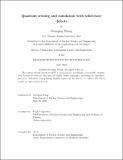Quantum sensing and simulation with solid-state defects
Author(s)
Wang, Guoqing
DownloadThesis PDF (68.25Mb)
Advisor
Cappellaro, Paola
Terms of use
Metadata
Show full item recordAbstract
Solid-state spin defects have garnered significant interest in recent years due to their potential for various quantum applications, ranging from sensing, simulation to communications. Despite the fast progress of the field in the past decades, numerous challenges remain before these applications can be fully realized in broader scenarios. Among the issues that need to be addressed are deleterious decoherence and low-fidelity control, and the lack of critical capabilities such as vector field sensing at nanoscale and arbitrary frequency field sensing. Additionally, a deeper understanding of the rich dynamics associated with the charge degrees of freedom of various defect states in the material host is necessary.
This thesis aims to tackle these challenges and contribute to the development of better quantum sensors and simulators. The study starts with quantum control based on modulated driving, which allows for the engineering of more flexible driving strength and the control of evolution modes. By utilizing modulated control techniques, we experimentally observe high-order effects beyond the traditional rotating wave approximation and protect Rabi coherence by more than one order of magnitude in an ensemble of NV centers in diamond. Moreover, we exploit the modulated driving to simulate dynamical symmetries and characterize their selection rules using projective measurements of the coherence evolution of the system. The same control technique is shown to further design parallel quantum gates for atom array quantum platforms.
Inspired by the flexible quantum control in different frames, we develop protocols to improve quantum sensing performances. In sensing coherent signals, we develop a protocol to sense vector ac field at nanoscale using a single spin. To broaden the frequency range of quantum sensors, we develop a quantum mixer to convert off-resonant signal fields to resonant ones, achieving the sensing of arbitrary frequency vector fields. To overcome the challenge of degraded coherence in large (nuclear) spin ensembles, we develop a novel unbalanced echo sequence to refocus the dominant noise in the intrinsic hyperfine interaction and quadrupole terms, which extends the dephasing time of a large spin ensemble to the single spin limit. In sensing stochastic signals, we develop a digital noise spectroscopy approach based on Walsh dynamical decoupling sequences to eliminate systematic error due to approximating frequency filters with delta functions. All these protocols are experimentally demonstrated with NV center platforms.
Given that the charge states of defects play an important role in the performance of aforementioned quantum applications due to their influence on the spin state and coherence, we use NV centers to probe the charge dynamics by characterizing the bath spectrum under different optical illumination conditions. With a fast wide-field imaging setup integrated with a SPAD array, we observe the process of charge transport through the redistribution of spin concentration of P1 centers and other spin defects in the bath. The potential tunability of spin concentration in time and spatial domain paves the way for their applications in simulating quantum many-body dynamics such as quantum hydrodynamics.
In summary, this thesis studied the improvement of quantum control and the development of better sensors and simulators with solid-state defects. Although experiments in this thesis are performed with spin defects in diamonds, many of the studied topics are general to most quantum platforms, such as modulated control, dynamical decoupling, coherence protection, noise spectroscopy, etc. Thus, we foresee broader applications of the thesis research outcome both in realizing quantum sensors and networks with solid-state spin defects, and in extending the developed control techniques for characterizing and improving the performance of other quantum platforms.
Date issued
2023-06Department
Massachusetts Institute of Technology. Department of Nuclear Science and EngineeringPublisher
Massachusetts Institute of Technology